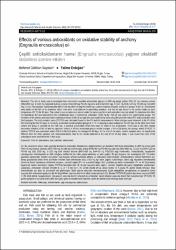| dc.contributor.author | Soydan, Mehmet Gökhan | |
| dc.contributor.author | Erdoğan, Fatime | |
| dc.date.accessioned | 2020-11-20T14:42:58Z | |
| dc.date.available | 2020-11-20T14:42:58Z | |
| dc.date.issued | 2019 | |
| dc.identifier.issn | 1300-1590 | |
| dc.identifier.issn | 2148-3140 | |
| dc.identifier.uri | http://static.dergipark.org.tr/article-download/beef/eba9/1d72/5df32aca87c47.pdf | |
| dc.identifier.uri | https://hdl.handle.net/20.500.12809/1135 | |
| dc.description | WOS: 000510854900007 | en_US |
| dc.description.abstract | The aim of study was to investigate four commercial available antioxidants (groups A (300 mg propyl gallate (PG)+10 mg rosemary extract (RE)/1000 mg), B (240 mg butylated hydroxy anisole (BHA)+80 mg PG+80 mg citric acid (CA)/1000 mg), C (120 mg BHA+120 mg PG+50 mg CA)/1000 mg), D (150 mg butylated hydroxytoluene (BHT)+100 mg BHA+10 mg PG)/1000 mg) used to evaluate oxidation during the storage in fish oil. Antioxidants were added to the fish oil to determine which ones were most effective in preventing oxidation, and fish oil was stored in the amber bottles at room temperature (20 °C) for 90 days. The control group samples were stored under the same conditions and antioxidant was not added. To determine the effect of antioxidants, the recommended by the manufacturer dose of commercial antioxidant (1000 mg kg-1 fish oil) was used in the experimental groups. The formation of the primary and secondary oxidation products in fish oil storage trial was examined by conducting the peroxide value (PV) and p-anisidine value (AV) analyses. The total oxidation value (TOTOX) was calculated based on the PV and AV measurements. Minor changes were observed in the PV of the fish oil during the first 30 days. In the study, antioxidant added samples (groups B, C, D > 5 meq kg-1) were oxidized on the 45th day; on the other hand both control and group A oxidized on the 75th day. A possible prooxidative effect was seen for some of the antioxidants. There was a very little change secondary oxidation of fish oil and no significant effects of all four antioxidant groups on the changes of AV (<20) during the storage period (P>0.05). In addition TOTOX was calculated under GOED (<26) limit during the storage for 90 days. At the end of the study, control samples were not significantly different from the other samples with antioxidant-added. Due to the results obtained at the end of the 90-day study, it was found that none of the antioxidants were used efficiently in this study. | en_US |
| dc.item-language.iso | eng | en_US |
| dc.publisher | Ege Univ, Fac Fisheries | en_US |
| dc.item-rights | info:eu-repo/semantics/openAccess | en_US |
| dc.subject | Fish Oil | en_US |
| dc.subject | Antioxidants | en_US |
| dc.subject | Lipid Oxidation | en_US |
| dc.subject | Stabilization | en_US |
| dc.title | Effects of various antioxidants on oxidative stability of anchovy (Engraulis encrasicolus) oil | en_US |
| dc.item-type | article | en_US |
| dc.contributor.department | MÜ, Ortaca Meslek Yüksekokulu, Su Ürünleri Bölümü | |
| dc.contributor.institutionauthor | Soydan, Mehmet Gökhan | |
| dc.contributor.institutionauthor | Erdoğan, Fatime | |
| dc.identifier.volume | 36 | en_US |
| dc.identifier.issue | 4 | en_US |
| dc.identifier.startpage | 367 | en_US |
| dc.identifier.endpage | 372 | en_US |
| dc.relation.journal | Su Ürünleri Dergisi | en_US |
| dc.relation.publicationcategory | Makale - Uluslararası Hakemli Dergi - Kurum Öğretim Elemanı | en_US |


















